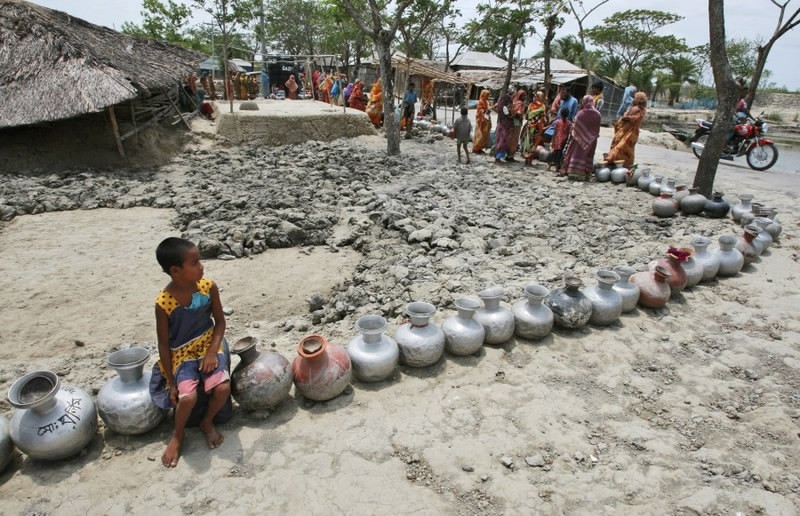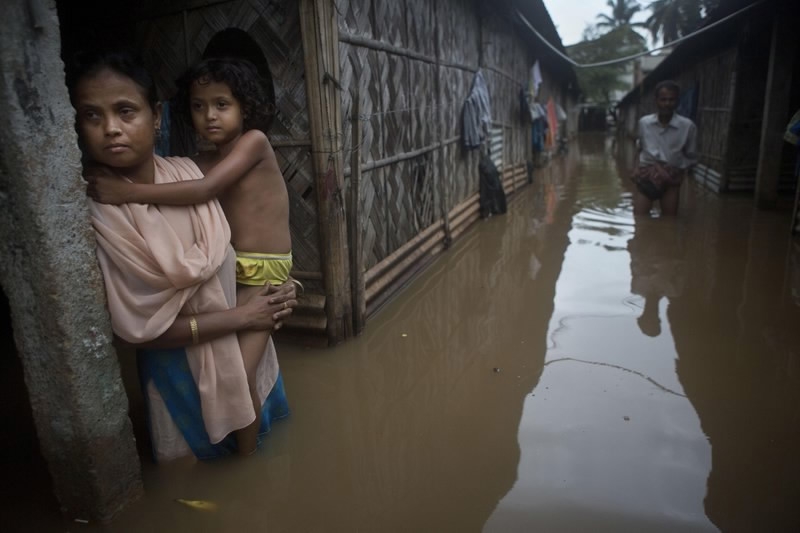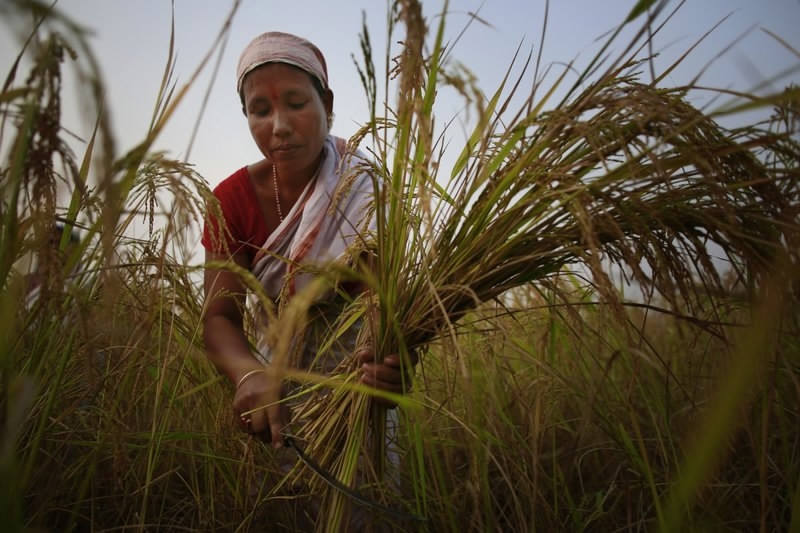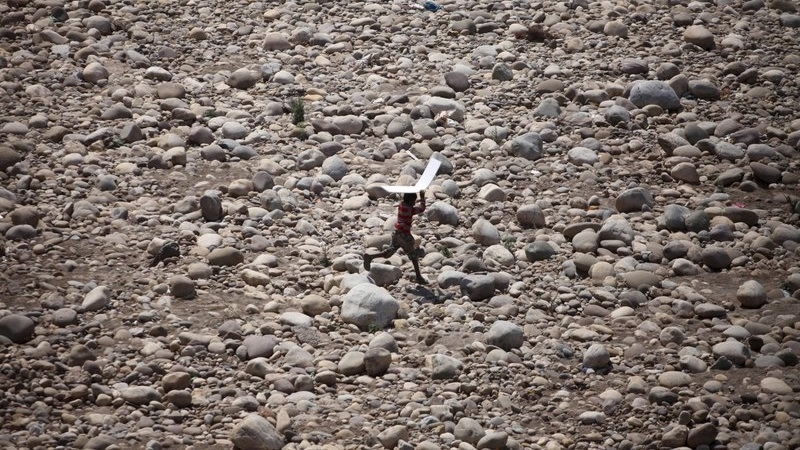A report by the Asia Development Bank (ADB) says Asia will endure extreme heat, rising sea levels, growing losses from severe weather and increasing food insecurity in coming decades as climate change raises temperatures and alters weather patterns across the globe.
The survey released on Friday by the Manila-based lender paints a grim outlook for many communities in Asia, home to about 4.16 billion people. It is based on the latest scientific research, with or without more aggressive efforts to curb carbon emissions that contribute to global warming.
Here are some of its main findings:
Extreme heat

A village girl sits on a vessel as she waits with others in a queue for water supplied by tankers at an area affected by last year’s cyclone Aila in Nildumur, Satkhira district, about 176 kilometers (110 miles) southwest of the capital Dhaka, Bangladesh. /AP Photo
A village girl sits on a vessel as she waits with others in a queue for water supplied by tankers at an area affected by last year’s cyclone Aila in Nildumur, Satkhira district, about 176 kilometers (110 miles) southwest of the capital Dhaka, Bangladesh. /AP Photo
Even if global warming is limited to 1.5 to two degrees Celsius (34.7 to 35.6 degrees Fahrenheit) above pre-industrial levels, from mountain communities in Japan to the tropics of South Asia and deserts of Australia, rising temperatures are altering ecosystems, damaging crops and causing thousands more deaths each year.
The report forecasts that Asian summer temperatures could rise by six degrees Celsius (42.8 degrees Fahrenheit) by 2100 if warming trends are not curbed. India suffered heat waves in 2015 and 2016 with temperatures at times around 50 degrees Celsius (122 degrees Fahrenheit). When temperatures stay above 35 degrees Celsius (95 degrees Fahrenheit) for extended periods of time, both people and animals are at risk of heat stroke.
Rising sea levels

A woman with her daughter in arms stands awaiting her husband who went to collect drinking water after flood waters entered their house following heavy monsoon rains in Gauhati, India, September 25, 2015. /AP Photo
A woman with her daughter in arms stands awaiting her husband who went to collect drinking water after flood waters entered their house following heavy monsoon rains in Gauhati, India, September 25, 2015. /AP Photo
Sea levels rose about 19 centimeters globally over the past century and are forecast to rise by about 2.3 meters for every degree Celsius of global warming as glaciers and ice caps melt, the report says, citing past climate observations. Losses due to coastal flooding of the world’s biggest cities are expected to rise to 52 billion US dollars a year.
According to the report, Indonesia will be the worst affected in Asia, with 5.9 million people flooded out each year by 2100. But across South Asia, 130 million people living in low-lying areas may be displaced under worst-case scenarios, it adds.
Extreme weather
Changes to the jet stream can bring on unprecedented rainfall and massive flooding. Floods in Pakistan in 2010, the worst ever, killed about 3,000 people and left millions homeless. While some areas are suffering extreme droughts, in Southeast Asia, the number of record-setting daily rainfall amounts doubled over the past three decades. Up to a quarter of Bangladesh is inundated in a normal year, and century-level flooding could put 60% of the country under water, the report says. Storm surges from tropical cyclones, destructive winds and landslides are other risks from weather extremes.
Food insecurity

A woman in a paddy field on the outskirts of Gauhati, India, one of the world’s largest grain exporters. /AP Photo
A woman in a paddy field on the outskirts of Gauhati, India, one of the world’s largest grain exporters. /AP Photo
A three-degree Celsius (37.4 degrees Fahrenheit) rise in regional temperature is likely to cause grain output to fall by up to 10 percent, the report says, causing tens of millions of people to go hungry. Weaker wheat yields in China and loss of rice paddy in Vietnam due to rising sea levels and extreme weather are among the changes expected in coming decades.
Meanwhile, desertification is spreading in Central Asia, a region where about seven to eight percent of the population lacks secured access to food. Growing ocean acidity due to changes in the atmosphere and warming temperatures are meanwhile straining marine ecosystems, hurting fisheries that are a crucial source of food across the region.
Health risk

A woman receives treatment at a fever clinic especially set up to cater to those suffering from fever, one of the main symptoms of several mosquito-borne diseases, at Ram Manohar Lohia hospital in New Delhi, India. /AP Photo
A woman receives treatment at a fever clinic especially set up to cater to those suffering from fever, one of the main symptoms of several mosquito-borne diseases, at Ram Manohar Lohia hospital in New Delhi, India. /AP Photo
Increased flooding can taint water supplies, increasing deaths from cholera and other waterborne diseases. Meanwhile, rising temperatures will further push tropical illnesses such as dengue fever and malaria into areas that once saw few cases, the report says. It also noted rising risks from displacement of communities due to flooding and rising sea levels, conflict over scarce water, malnutrition and other troubles brought on by climate change.
Migration
The combination of all the trends above will put heavy demands on scarce resources at a time when larger numbers of people are migrating to escape rising sea levels, extreme weather and drought. At the same time, climate-related disasters are likely to cause economic disruptions across many regions. “The magnitude of the challenge for the people of the region is immense, with the livelihoods and welfare of hundreds of millions of people at stake,” the report said.
(Source: AP)






